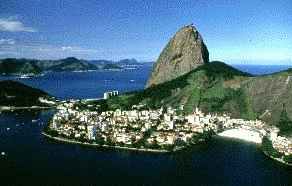ROMPING THROUGH RIOSamba, Safety, Soccer and Sun.
by Annette LucidoEven the sidewalks deserve a close look as you amble through Rio -- the most exciting city in South America. They alternate white and black stone blocks brought from Portugal as ballast. But Rio isn't scenery, or shopping or cultural activities even though Rio has all of this and more. It's people -- the Cariocas.
It's the clerk who takes you down the block to sample a special pastry and some lethally strong coffee. It's the boy on a bus who shows you his favorite spot on the beach. It's the waiter who talks about modern art and tells you how to get in the back door so you don't miss the Rodin Exhibit. It's the hundreds of thousands of screaming, flag waving, foot stomping, arm shaking fans who root their team to victory in Maracana Stadium. It's the mannerly fellow at the golf club who, when your change fails, signs for your fruit drink. 
Rio's mountains and beaches -- like no others in the world.
PHOTO CREDIT: RIO TOURISM
Cariocas call Rio "Cidade Maravilhosa." It should be "Cariocas Maravilhosas." So if you visit, practice saying "Obrigado" or thank you. You use it a lot. Whip out a map, and folks stop to help. Dust off high school Spanish -- portuguese is close -- or some Italian, and you'll get a gentle smile and, often, a bit of helpful English. Manners haven't died in Brazil.
But is Rio safe? You've heard the stories. When you get there ask about the politics of those now fading reports. In the meantime, apply the "13 year-old-girl rule." If you see pubescent girls in shops, on streets, in buses and at the beach, tourists who don't flaunt their wealth should be safe. Certainly there are spots in Rio away from the tourist sections patrolled by tourist police, where you can get robbed -- especially at night. With 6,000,000 people you get a few bad coconuts. Been to LA or New York or Paris or any other large city lately? Just take the same precautions you would in any big city and you'll be fine.
With that hurdle past, let's romp through Rio. No place in the world offers so many beaches -- and, as my husband notes, ". . . or such tiny bathing suits," No place offers majestic mountains lapped with warm ocean waters downtown. Incidentally, a local claims the tourist police won't let you you leave the country if you've not been up to the Corcovado with its Christ statue or swayed across on the cable car to Sugar Loaf. But if you tour in the back seat of a cab or tour bus you simply meet other tourists. Get out on your own feet and meet the Cariocas, the natives who make Rio a romp!
Start downtown --Centro or Cinelandia -- the latter for the many movie houses -- during business hours. Eye the Opera House and National Library -- book stalls in their square remind us of Paris. Venture into both if you have at least an hour for each. Prowl the National History Museum built in 1765 and you may need two hours and a coffee break to even sample the over 200,000 exhibits.
Stroll around in Praca XV, a splendid old part of town with its narrow streets, small shops, nifty little regional restaurants, corner juice and coffee stands. There seems to be a public or private museum around every corner of what one local calls the "happy hustle" of downtown. Sip coffee in a sidewalk cafe. Riffle through the art prints in a stall or shop. Check out the SaoBento Monastery or the trolley line. It's a day to remember and like the Lelron Mall, a wonderful rainy day choice.
If you bus back toward the beaches, stop at the Modern Art Museum in the Park on Guanabara Bay -- there's good bus service. Skip the nearby Carmen Marinda Museum Do check museum hours carefully; they tend to vary.
The parks deserve special mention with Rio's "downtown" Tijuca Forest, the largest urban forest in the world, and its world-class Botanical Garden's row of Royal Palms. Small parks, big parks, mountain parks, historic parks, Rio does have parks that seem to fill up on the weekends with family picnics and soccer players. Stay with the crowds and you're quite safe. Note: we'll cover out of town parks and museums elsewhere!
Rio's Real Dangers
Rio does offer three real dangers: samba, sand and shopping. The first's a must nightlife stop if you take along a bit of tissue for each ear and realize those tasty fruit drinks might bite overnight. Samba shows do start late, so don't plan much more than the beach the next morning. Samba's hot, hot, hot, and loud, loud, loud. And if you're lucky enough to make February's Carnival, wild, wild, wild
Sandy beaches filled with nubile ladies can get husbands in major trouble -- mine sneaks peeks with the aid of dark glasses. So eye control's a must, and swimming's safe if you watch the locals -- not that there's a problem doing that. Copacabana and Ipanema are the best-known beaches, but the 12 mile stretch of beach of Barra da Tijuca deserves a look. It offers a chance to try hang gliding off the cliffs too. Need more exercise? Tennis clubs welcome visitors. If you golf you'll find two great courses under the mountains -- our choice is the Gavea Golf and Country Club, home of the Brazilian open. Your hotel can set this up.
Shopping (if you're a jewelry fan you know you're in trouble when the shops start to send their limos to pick you up even though most hotels have at least two jewelry shops) hazards the family plastic. Emeralds -- do I love emeralds -- and a host of colored stones are much, much less expensive than anywhere else we've been. So you can get both the necklace and the earrings, yes? There's wonderful summer and resort clothing -- buy your summer outfit in the winter and you're a year or two ahead. There's even better leather. There's even a Sunday "Hippie Market" in the park in Ipanema for those who like to bargain. So it's "shop until you drop."
Fortunately, you're never far from food breaks. You can find European meals in a host of restaurants international and otherwise in hotels like our favorite La Pergola Restaurant in the Copacabana Palace at the beach -- ask for the Bahian shrimp and coconut chowder. You can also find, and should ignore, the Golden Arches.
We like to "eat street" during the day and save our food dollars for special lunches or dinners at top spots. We start our day with fruit, a coffee and pastry. A fruit drink or more coffee handles mid-morning. Share a stand with Cariocas and you can wash down nifty meat pies or sandwiches with a host of exotic juices like tamarind at lunch. Small local restaurants, many with sidewalk tables, serve wonderful all-you-can-eat barbecue -- it's called "churrascaria." You won't recognize all the bits and pieces so we taste first and then ask. Another treat's Brazil's national dish, Feijoaoda, made from black beans.
However, Rio glories in its splendid fish dishes from the Bahia and other coastal areas. Shrimp, squid, all sorts of fish come alone or in delicious combinations like those served at Sol & Mar. So we check buffets where we can graze through the list. Much of this will seem a bit salty at first -- in this climate you probably need more salt than at home. Then there are deserts. Boy, are there desserts!
You could make a case that Rio is really all desert for visitors. Rio is far enough from North America, Europe or Asia so that you want to allow time to visit falls, check the mountains, ride in Petropolis horse-drawn carriages, sail through the Angra dos Reis or catch a fish on the Sun Coast. A three day visit to Rio is like standing in a wonderful candy store with only a single choice. A week's barely enough for Rio, a month would be nice for Brazil and, if we could figure out how to move our work, a year wouldn't be wasted. It's that kind of city and country!
